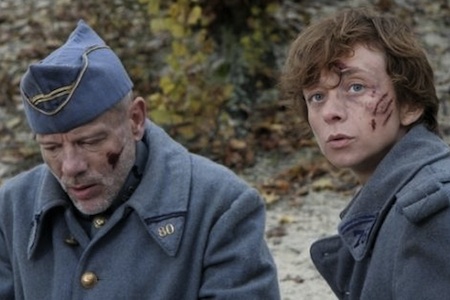A group of women stand atop a lush hillside looking off at some unseen horizon. Framed in long shot, these faceless souls appear like stick figures populating a lush and serene mise-en-scène. But their calmness is misleading. One by one, each starts descending the hill, running rapidly toward the camera and eventually passing by it entirely. If there’s one constant in Serge Bozon’s entrancing and strange WWI film La France, its that perspective, both near and far, will eventually overlap in fascinating ways. The proximity of things in any given moment creates meaning.
It makes sense then that foreground and background space weave together like entangled snakes throughout the film. One never evolves without impacting the foundation of the other. It’s a compositional approach that makes even La France’s most static images come alive; their dynamism is not defined by camera movement but depth and duration of the shot. As a result, what begins as a seemingly straightforward story of one woman’s odyssey through combat-riddled France turns into a masterful study in contrasts–war and peace, life and death, music and silence—that often reside in in the same frame.
Camille (Sylvie Testud), a recently married waif awaiting her husband’s return from the front, experiences the contradictions of war within this cinematic framework. After receiving a disturbingly fatalistic note from her beloved early in the film, Camille leaves the safety of her quaint village and ventures out into no man’s land to get some answers, risking life and limb in the world of men with guns. Along the way she comes across a platoon of French soldiers who claim to be rejoining their brethren to fight the Germans. The short dialogue-less sequence that builds to this introduction brilliantly displays Bozon’s graceful use of character blocking, depth of field and timing.
It’s a compositional approach that makes even ‘La France’s’ most static images come alive; their dynamism is not defined by camera movement but depth and duration of the shot.
Camille’s drive and courage could initially be mistaken for melodramatic impulse, which makes the series of shots all the more essential to Bozon’s complication of gender roles. The camera begins at Camille’s waste as she reaches the edge of a treeline, subtly rising to hover behind her head revealing an open patch in the forest. Firmly planted in foreground left, Camille pushes down a branch to clear her view and the camera’s. She watches as the soldiers emerge in a single file line background right, dots of gray framed by a wall of green. Camille moves forward slowly, her curiosity obviously piqued by their sudden presence. Only thunder breaks the silence before the men disappear from view.
The motif of watching continues when Bozon uses a graphic match to cut hours into the future, the camera still firmly planted behind Camille as she observes from afar the soldiers already bunked down for the night. A single edit pushes what could be Camille’s perspective even further into the camp. One sleeping soldier dominates the foreground while others litter the background space. Then, Camille suddenly emerges from frame left, walking through the camp before stopping in the center of the space, examining the men as they rest peacefully. Bozon’s camera seemingly takes on Camille’s perspective again, punching in for medium-close-ups of individual soldiers sleeping before finally landing on one young man whose restlessness is obvious. But perspective is always distrusting in La France, and Camille enters the shot and lies down next to the soldier.
Watch a scene from La France.
This entire sequence is striking for it’s clarity of time and space, becoming an aesthetic microcosm for the entire film’s melancholic view of a sobering world merely a few steps removed from combat. This singular theme is further explored through the oddly enchanting musical numbers that define the film’s beguiling tone.
But as the La France progresses, markers of war and death do begin to taint the foreground/background relationship in the images. A lifeless body floats down a river, one figure climbs a watchtower to murder another, and a barn burns to the ground in the dead of night. Still, no matter the implication of violence, Bozon stays true to the idea that each image in La France has multiple planes of experience going on at once, and the complex juxtaposition of competing actions is what matters most. Each character’s motivation and melody resides in the layers of the frame, in between the sight lines and off in the distance.




